I’ve been seeing images of José Naranja‘s notebook pages on Pinterest for quite a while, but it is only since joining Instagram that I discovered the full depth of his amazing work.

His notebook pages are incredibly detailed, with writing, drawing, and collage elements– it’s the kind of notebook art where you really wish you could just hold his notebook in your own hands and flip through it. And the good news is, you almost can!
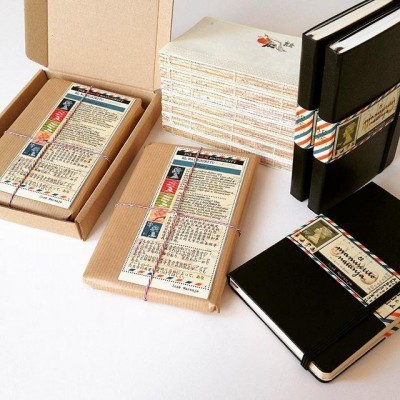
José sells facsimile notebooks containing a selection of his best pages under the title The Orange Manuscript, beautifully printed and hand-bound in an actual pocket-size Moleskine cover. They are expensive (285 Euros, which includes tax and shipping worldwide) but worth it! The Orange Manuscript is truly a work of art, even down to the lovely packaging– I am so glad I bought mine and never tire of looking at it! (I paid full price and have not received any compensation or commission for this review and interview, just to be clear.)
José muses about life, art, travels, imaginary inventions, and about notebooks and pens themselves. He packs so many details and fanciful elements into each page, they are continually fascinating and inspirational. I really wanted to know more about José and his world of notebooking, so I was thrilled that he was willing to answer some questions. The interview below has been slightly condensed and edited for clarity, and I’ve added a few of José’s images from his blog.
NS: I want to start by talking a little about your art itself, which is so beautiful, with a wonderful sense of color and texture and design. It is very interesting seeing how your pages seem to have evolved from simpler single images to your current style of very dense pages with lots of stamps, writing and multiple images. What is your process for designing and laying out a page? Do you plan it all out in pencil first and then add drawing and writing and paste objects in, and then finish it in ink? Do you work on multiple pages at once, or do you finish a page before starting a new one?
José: That’s been always my fight. I want the pages to be natural and full of freedom. However if I don’t make a plan in advance or do a draft in pencil, the result is not always great. Sometimes it’s actually amazing, but most of the time could be quite bad. I try to find a balance. The notebook has many pages so I can experiment with different styles.
I use a template to write straight and for some pages I do a draft in pencil. Anyways I’m not worried about making mistakes, they make it real and they are welcome. Beauty is in reality. I write one page after another, with many gaps to fill later, so I can say I work in several pages at the same time.
I have noticed references in your art to (among others) Vermeer, Picasso, Velasquez and Leonardo– some of your pages make me think of Leonardo’s notebooks in the way that you are exploring ideas. Are there artists who particularly inspire you with their use of notebooks/sketchbooks (as opposed to their larger paintings or work in general)?
Definitely Leonardo was able to produce magic in each brushstroke. He did notebooks and I consider him one of the most inspirational artists ever. However, regarding notebooks, I have the feeling he did them in order to create a kind of encyclopedia or serious book, not a personal journal. For me the artist who created the most amazing and personal notebooks is Peter Beard. He made an artwork from his life. In general I find inspiration in many places, of course from the greatest painters as Picasso, Velazquez or my favorite Dali.
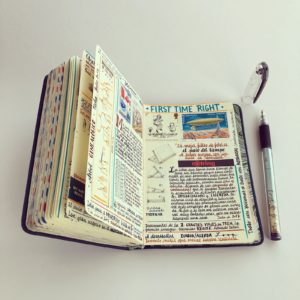
You mention that you worked as an engineer– did you have formal training in technical drawing because of that? (I definitely sense an engineer’s mind and curiosity and inventiveness in other aspects of your work beyond just the precise drawing style…) Did you have any other training as an artist or are you self-taught?
I spent many years studying and working as Aeronautic Engineer. Unfortunately when I started working, drawings were already made by computer so I’ve never drawn any technical thing as part of my job (which I’d wish, btw) or received any drawing or art classes. I just try to do as well as I can, observing and feeling. I guess I can make disappear my technical background. I’m as interested in Science as in Art.
The tricky thing about creating art in notebooks is figuring out how to share it, but you have found a great solution in selling prints and facsimile notebooks.
Yes, you are right. Creating the Orange Manuscript as a facsimile was a brilliant and unexpected solution to share it. The goal is people can feel it in their hands with the same paper, etc. Fully touchable, much more different than watching photos in a screen computer or mobile.
Now let’s talk about notebooks themselves! As important as the art is, I know you really care about the notebook that holds it and I love that you refer to yourself as a notebookmaker.
From looking back at your blog and instagram, it seems like you mostly were interested in photography at first, and then started posting more about notebooks when you started using Moleskines. Did you always use notebooks? What other brands have you used? Do you keep rough notes totally separate so your handmade notebook only holds the fully designed and finished pages? Or do you ever just scribble a casual note in the handmade notebook?
Photography has been always my main passion. I also wrote notes here and there all my life, not always in notebooks. But I never imagined they could be fascinating or something special. I realized that when I post them in Internet and I saw people’s reaction.
When I discovered Moleskine pocket journals in 2005 (the ones with hard cover and elastic around) I was so happy and shocked that I decided everything I write from that moment was in that new amazing format. And it was like so up to now. In the last years I modified the paper and finally the whole notebook, but keeping that format. The rest of the journals I use are as a secondary notebooks for fast notes (Field Notes, Muji or handmade ones). The final work is the handmade notebook, where I put my time and passion. I also write some of the ‘casual notes’ on it, in certain pages.
I was amazed to see that you used to use the plain Moleskine rather than the sketchbook version with the heavier paper. You then started replacing the paper inside Moleskine covers (great tutorial!), and eventually switched to making your own leather-covered notebooks completely by hand. Even back when Moleskine’s quality was better, the paper was thin, and you use a lot of fountain pens– didn’t they ever bleed through the pages? Did you use both sides of the page?
Exactly. I used them during many years but I didn’t use fountain pens or watercolors then. My writing tools were quite simple and my goal is to be simple again. The problem is… who could resist so many great inks and fountain pens? What a temptation!
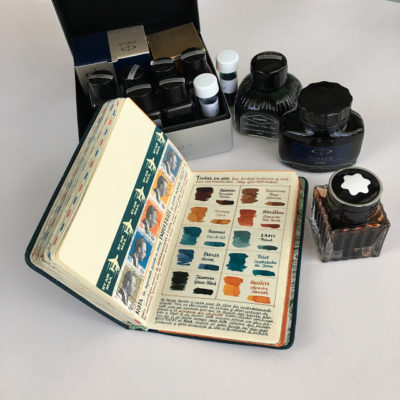
Your handmade notebooks are beautifully made– did you have a lot of trial and error to get them just right? You have made them thicker than Moleskines– are you enjoying using a very fat notebook with lots of pages? When I use a notebook, sometimes I feel like I want to fill all the pages and use it up quickly so I can start a new one. Sometimes I love the notebook I am using so much that I never want to finish it, and I start trying to use every bit of space on each page. Do you like using the same notebook for a long time? The leather covers must age nicely!
Yes, I love using the same notebook for long time. Every day, every word, every sketch and every trip adds more value and ‘spirit’. It goes better with age and it has to be like that. I didn’t have many problems to make the new ‘fat’ notebook since I got a lot of practice making the Orange Manuscript one by one. What was new for me was the leather cover, easier than I thought. Maybe next notebook is even fatter? I have to think about it.
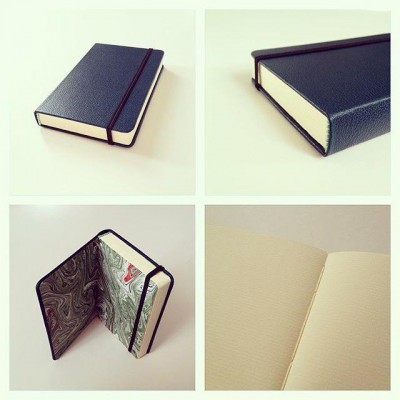
How many notebooks have you filled now? Do you also save all the Field Notes books, and any others, after you use them? Do you go back and read through your old notebooks alot?
I’ve filled 12 notebooks already. I also keep the auxiliary notes but I don’t think they are relevant. I always scan the notebooks and keep them in the computer and mobile, very useful when I travel. So many notes with worth information I really need all the time.
There are lots of other questions I would love to ask about your life, travels, and art supplies but I will just finish with this: will there be an Orange Manuscript Volume 2??? If so, sign me up for a first edition!
Yes, I’m thinking seriously about a second manuscript, with a name to be decided. I have enough stuff to do it but at the same time is a huge work to prepare it, doing print test, etc. But it’s enjoyable time, specially when I see nice people like you who are already interested already in a second volume. Many thanks!
I really do hope José continues to share his amazing imagination and intelligence in facsimile form. His art continues to evolve so that his notebooks are not just a collection of individual pages, but a thought-out whole, with design elements linking the pages together almost like a mystical treasure map, as he shows in the below illustration about the golden ratio motif in his latest notebook.
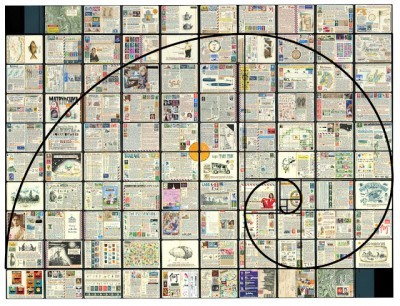
Please check out José’s Instagram feed, and his blog, where you can find out more about the Orange Manuscript and order a copy. He also sells prints.
My thanks to José for sharing his story with us!

Thank you for a wonderful interview. I have followed Jose’s art for some time now and it was nice to learn more about him as an artist. His notebooks are incredible and are an inspiration to a budding artist like myself.
Great interview, Nifty! You asked all the kinds of questions I would have asked. I’ve been following Jose’s work on IG for a while, continually amazed and dazzled. Learning how he got to this point is fascinating. Thank you!
– Tina